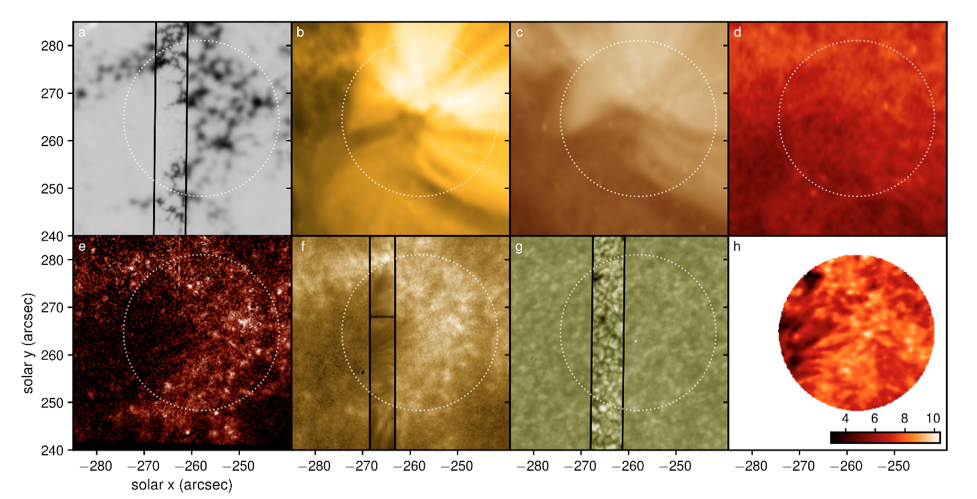Observations in the ultraviolet (UV) taken with the Interface Region Imaging Spectrograph (IRIS) have shown that the bright magnetic patches, known as plage, typically feature broader and brighter MgII h and k lines, which suggests that the chromosphere above plage is hotter and denser than in the quiet-Sun (e.g., Carlsson et al. 2015). However, not all line broadening is thermal; a nonthermal broadening component of up to 10 km s$^{-1}$ has been measured in the optically thin OI 1356 Å line (Carlsson et al. 2015), while similar values were inferred from non-LTE inversions of the MgII lines (e.g. de la Cruz Rodríguez et al. 2016). The source of high microturbulence remains unclear, but possible explanations may reside, for example, in magnetoacoustic shocks from below and Alfvénic turbulence (see review by Carlsson et al. 2019 for further details).
The Atacama Large Millimeter/sub-Millimeter Array (ALMA) offers a new view into the solar chromosphere at radio wavelengths and a convenient LTE diagnostic potential that should help diagnosing local temperatures (e.g., Wedemeyer et al. 2016). This is encouraged by experiments based on synthetic spectra from 3D MHD simulations which have shown that one can infer temperatures more accurately when IRIS near-UV lines are simultaneously fitted along with the millimeter continua (da Silva Santos et al. 2018).
All eyes on a solar plage region
This work resulted from a coordinated campaign between ALMA and different space telescopes. The figure below shows different images of a plage region taken by SDO, IRIS, Hinode, and ALMA on 22 April 2017. The magnetized areas which appear as bright patches in the ultraviolet passbands have an analogue in the ALMA interferometric maps.

Figure 1 – Plage region observed by SDO, IRIS, Hinode, and ALMA. a) SDO HMI & Hinode magnetograms (background & raster, respectively), b,c,d) SDO AIA 131, 193, 304 Å, e) IRIS SJI 1440 Å, f) IRIS SJI 2796 Å & IRIS k line core (background & raster, respectively), g) IRIS SJI 2832 Å & Hinode 6302 Å continua (background & raster, respectively), h) ALMA Band 6 brightness temperature in kilokelvin scale (da Silva Santos et al. 2019).
Improving inversions of NLTE ultraviolet lines using ALMA observations
We used the Stockholm Inversion Code (STiC, de la Cruz Rodríguez et al. 2016) to fit IRIS and ALMA data at the same time in order to constrain temperatures and microturbulences in the vicinity of the plage region. The inversions show that plage regions are columns of enhanced temperatures from the photosphere to the transition region compared to the weakly magnetized areas. However, the inverted temperatures inferred from the MgII lines alone are unable to accurately predict the observed mm continuum; this is probably a sign of (1) a bias introduced by NLTE effects in the MgII lines and/or (2) non-equilibrium electron and proton densities that may be needed to compute the opacity of the ALMA band (e.g. Wedemeyer-Böhm et al. 2007). The importance of non-equilibrium calculations is emphasized.
Hot shock fronts and cool clouds
One of the most interesting aspects of this ALMA dataset is the broad range of brightness temperatures: ~2900 – 12500 K, which is quite impressive for chromospheric standards. Our inversions suggest that there are regions in the chromosphere in the vicinity of plage regions where the gas temperature drops significantly, possibly allowing for molecules such as carbon monoxide to form, whereas at other locations the temperatures suddenly increase in response to dissipation of magnetoacoustic waves. Follow up work is needed to understand the impact of shocks in the heating of plage regions.
 Figure 2 – Time evolution of a subfield in the ALMA data (from the left to the right). The dashed contours correspond to 9000 K. The ALMA maps show both cool (~3000 K) and hot (~11 000 K) compact (~1-2”) features evolving on scales of a few minutes (da Silva Santos et al. 2019).
Figure 2 – Time evolution of a subfield in the ALMA data (from the left to the right). The dashed contours correspond to 9000 K. The ALMA maps show both cool (~3000 K) and hot (~11 000 K) compact (~1-2”) features evolving on scales of a few minutes (da Silva Santos et al. 2019).
Conclusions
IRIS diagnostics greatly help us to interpret ALMA observations because they provide complementary information on temperature, line-of-sight velocities, and microturbulence. Our empirical models imply that the chromosphere of plage is slightly hotter and with lesser microturbulence (or non-thermal broadening) than measured before, and our temperature maps have an increased contrast. This work shows that the combination of IRIS and ALMA is a powerful tool for diagnosing a wider range of physical conditions in the solar atmosphere and it reiterates the need for more coordinated observations in the future.
Based on the recently published article by da Silva Santos, J. M., de la Cruz Rodríguez, J., Leenaarts, J., Chintzoglou, G., De Pontieu, B., Wedemeyer, S., & Szydlarksi, M., Astronomy & Astrophysics (2019), DOI: https://doi.org/10.1051/0004-6361/201937117
Free copy of the paper available in the author’s page.
References
Carlsson, M., De Pontieu, B., & Hansteen, V. 2019 ARA&A, 57, 189
Carlsson, M., Leenaarts, J., & De Pontieu, B. 2015 ApJL, 809, L30
da Silva Santos, J. M., de la Cruz Rodríguez & J. Leenaarts 2018, A&A, 620, A124
de la Cruz Rodríguez, J. Leenaarts, J. & Asensio Ramos, A. 2016, ApJ, 830, L30
Wedemeyer, S., Bastian, T. & Brajša, R. et al 2016, SSRv, 200, 1
Wedemeyer-Böhm, S., Ludwig, H. G., Steffen, M. et al 2007, A&A, 471, 977
